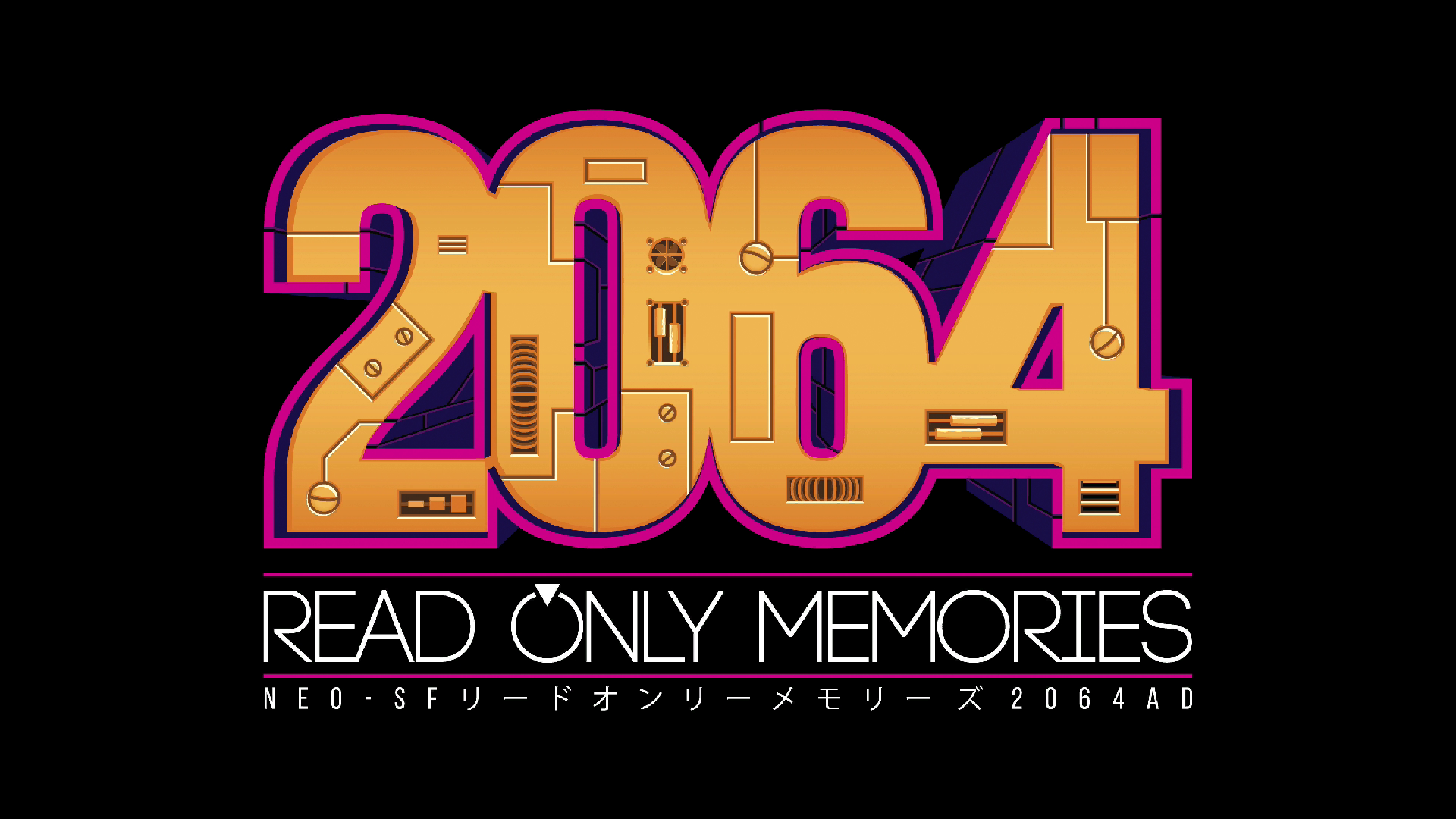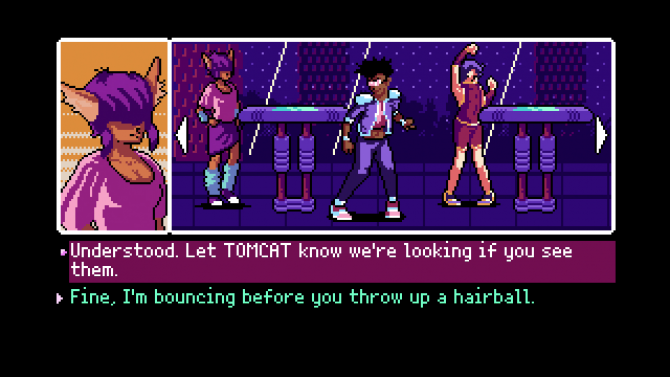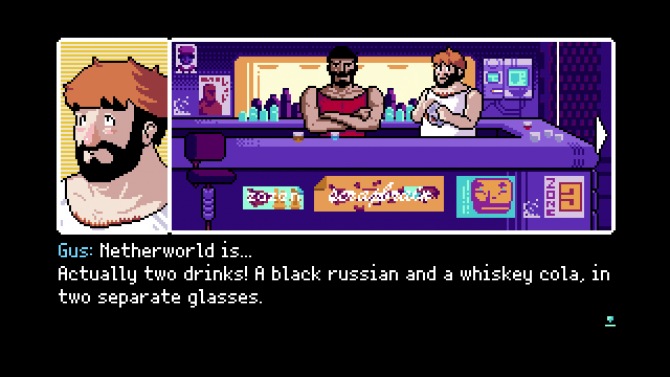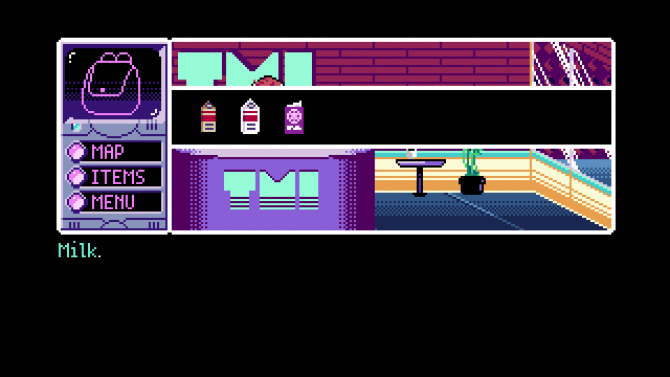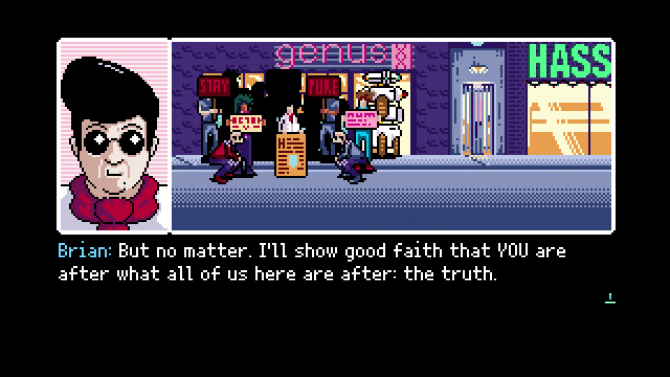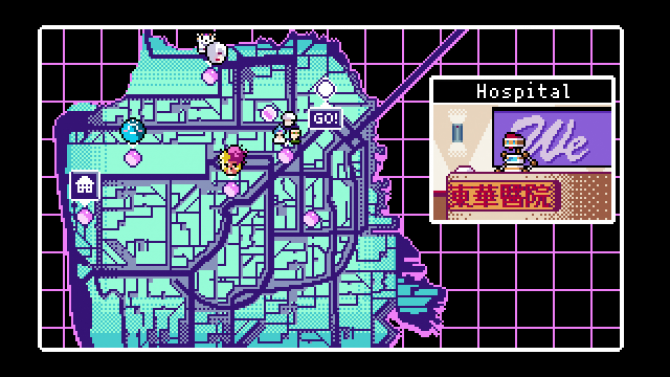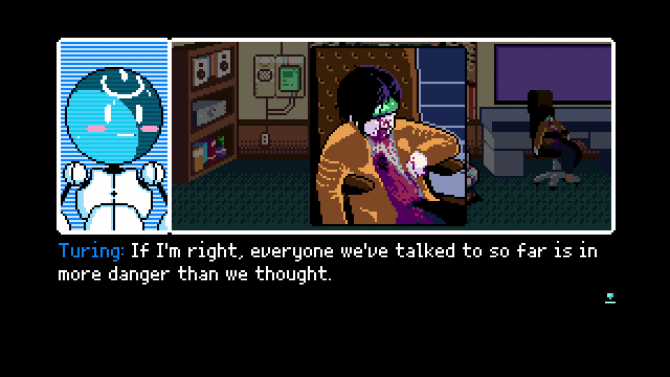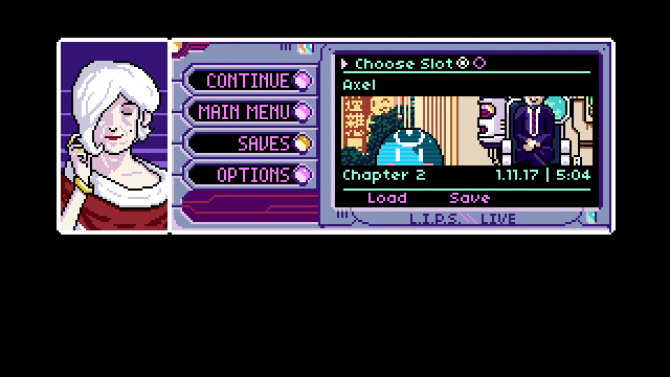As an adventure game, 2064: Read Only Memories has to contend with delivering gameplay that won’t become obtuse to the point of absurdity and a narrative to keep the player compelled to move forward even if the way you play isn’t fun. Thankfully 2064: Read Only Memories keeps the puzzles light, though it can be a toss-up on whether or not they are clever or just a series of guess and check. Focusing on characters, interactions, and interpersonal relationships was the correct decision, all of which are strengthened by a capable voice cast and well-realized cyberpunk future of San Francisco.
Interactivity between yourself and the game in 2064: Read Only Memories is in line with most point and click adventure games. You can select dialogue responses to characters, most of which will lead down a two-way road of secondary characters either favoring or resenting you by the end. There is a consequence for maintaining positive or negative relationships when the climax of the narrative comes around, which may either inspire you to replay the game and choose the opposite path or watch a video of the differences.
Another choice is how much you want to question characters, as you can generally spend quite some time going through each line of questioning presented as well as observe and attempt to interact with everything on-screen from plants to objects and people. Sometimes you will be given an opportunity to talk your way into a favor or some additional information that may or may not help your quest. Maybe it will give you a new lead, further insight into motivations, or just speed up progression towards a goal. It is both in these occurrences, as well as a few puzzles, that you may run into frustrations regarding presentation.
As an adventure game, puzzles fall into a few categories. Using the right item on an object in the world, or picking the right line to get what you need. Delightedly 2064: Read Only Memories is forgiving in the latter, allowing you to move forward even when you have failed a scenario. This will not always hold true for every single scenario, and as the game offers no auto-save you should be saving frequently to avoid replaying lengthy stretches of the game.
There are a few puzzles in particular that I did not feel clever solving, and instead had to brute force my way through. One early on tasks you with assembling the correct drink for a patron at a nightclub and smooth talk your way into the VIP area. You are given hints for each person’s taste, but once you approach the bar and are given the list of drinks there is no detail as to its ingredients unless you engage with a lengthy enough dialogue tree. This process wore me down the longer I engaged with it, attempting to find something bitter. Eventually I resorted to scouring the internet for help as the total drink list tops out at fifty-three.
Other puzzles involve blocking pathways to either avoid or intercept a moving object, matching patterns to images in a CAPTCHA fashion, and utilizing the correct item with a person or object. Some of those in the last half can be deduced by the situation’s needs, and others will require you to use each item until one works since no visible clues are given. Throughout the six chapters these puzzles are spread pretty evenly, so even if you encounter a more aggravating one the game gives you time before the next.
With gameplay options pretty limited, 2064: Read Only Memories has to lean more on its narrative delivery to keep players engaged, and thankfully it succeeds in doing so.
The relationship between yourself and the sapient ROM Turing who serves as the catalyst for the adventure on display is the main thread that will keep you moving forward. After a short introduction to the game mechanics via your apartment and completing a written assignment Turing breaks in the following morning and explains their situation. Turing’s creator, an old friend of your own, has gone missing and Turing suspects foul play is involved.
Enlisting your aid, the two of you proceed to hunt down leads, work with various secondary characters who help you progress further towards the truth and help fill in pieces of the world to make Neo-San Francisco feel like a fleshed-out cyberpunk future. ROMs are most everywhere assisting humans and the city, hybrid humans are marginalized for their tampering of genes and face a purist movement, VR dramas are big entertainment draws, portions of the city are automated, and portions of the city are just as dirty as in our own time.
Voice acting, a new feature not included in the original PC release of Read Only Memories, goes a long way towards establishing Neo-San Francisco as a fully realized setting. All major characters are voiced, with most of the voicework containing quality performances. Depending on how closely you follow certain figures in the video game coverage industry, you may find yourself chuckling a little bit at recognizable voices featured, such as Jim Sterling and Dan Ryckert.
Sterling waxes poetic about the potential harm hybrids could introduce with the same performance he brings to his YouTube channel, and Ryckert can’t help but verbally daydream about wrestling. Their performances, especially Sterling’s, are good, but also recognizable enough that it brings me a bit out of the overall experience.
Turing’s voicework is especially good, and needs to be since they’re your partner and most talkative of the cast. Tomcat, Lexi, Chad, and especially Dekker near the end, all give wonderful performances full of compelling emotion that helped me grow attached to their character. Corresponding with the dialogue are character boxes that appear whenever that person is speaking, and frequently features animations reflecting the character's mood. Turing, due to their digital display for a face, is especially capable of expressing a wide range of emotion, not only in the audio of their voice but also in the display of their blue head.
Due to the throwback presentation of the graphics, as everything is displayed in pixels reminiscent of a tuned-down version of Snatcher from the Sega-CD. A majority of the screen is dedicated to displaying whatever location you are in, with a screen on the left portion of the display containing the map, items, and menu options. The bottom portion is dedicated to displaying the text of other characters and yourself.
On PlayStation 4 you can not only interact with everything on display with the directional pad but also utilize the touchpad as a mouse of sorts complete with cursor and light taps as clicks. There is enough detail on display throughout all of 2064: Read Only Memories that you can get a feel for each area, from the clean upper end of Market Street to the greenery of Golden Gate Park. Character portraits are given much more love and detail, which is fitting considering those are the main feature to keep the player engaged.
Without spoiling too much, there are several worthwhile revelations spread throughout the story-arc of 2064: Read Only Memories. Not every character is given some incredibly detailed or interesting backstory, but there are enough secrets revealed to keep you curious about what you may learn next. The antagonistic force working against you is a background threat for much of the game but reveals itself in a very satisfying way during the climax.
Even if the gameplay utilized during this period was a re-worked access puzzle I didn’t perform particularly well at earlier I enjoyed the payoff of the dialogue enough to see it through. There is even an epilogue after the credits that allows you to follow up with several key characters post-resolution to see how things have been. It is a nice little ending and a sweet send off of those you befriended along the way.
The only major frustration I came across during my ten or so hours with 2064: Read Only Memories was a combination of the game soft-locking and the lack of auto-save. While I acknowledge that the game reminded me to save often, I also did not expect it to dead end me in a way I know was not intended by the developer. During the final stretch of Chapter 6 I was confronted and used all my energy to retaliate but the game did not react. Instead I was presented with a hostile on-screen with the music playing as normal but with no way to interact or exit out. In short, I had to reboot the game and replay the ending of Chapter 4 up to that moment again.
While it was easy enough to navigate roadblocks I had just discovered and overcome shortly beforehand, it was still a hassle to tap my way through lengthy conversations. I nearly landed in the same situation, but this time the game recognized my input and I could progress, whereas last time I was stuck. I should have saved closer to that point, but the game should also not soft-lock me and force a reboot.
I enjoyed a lot of what 2064: Read Only Memories had to offer. Gameplay is focused on dialogue and puzzles, and while the latter can be a toss-up between frustrating and satisfying, the former outshines it in both quantity and quality. If not for the relationship between yourself and Turing, as well as the backstories, interactions, and performances of the secondary characters, there wouldn’t be much to keep one engaged. Thankfully all of that is present and make Neo-San Francisco and the stories it holds worth playing through to the very end.

